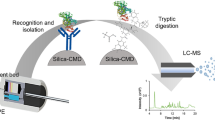Abstract
In our work, a new extraction tip with gold-modified polymer is developed. The simple, self-made and extremely economical tips were successfully applied to capture cysteine-containing peptides. The loading capacity of a tip (column bed: 0.3 mm diameter, 5 mm length) is 2–4 μg peptides. We can make one tip in 30 s and each costs less than 0.1 cent. The use of these tips can achieve a stable analysis with less background interference, even for 10 ng target peptides. Compared with other separation techniques, our method can save much time and energy while providing a means to selectively capture cysteine-containing peptides from complex analyte due to the strong interaction. All results showed that our new extraction tips have minimal cost and perfect selectivity; thus they have great potential in sample pretreatment systems for proteomics.
Similar content being viewed by others
References
Wilm M, Mann M. Analytical properties of the nanoelectrospray ion source. Anal Chem, 1996, 68: 1–8
Kussmann M, Lassing U, Sturmer CA, Przybylski M, Roepstorff P. Matrix-assisted laser desorption/ionization mass spectrometric peptide mapping of the neural cell adhesion protein neurolin purified by sodium dodecyl sulfate polyacrylamide gel electrophoresis or acidic precipitation. J Mass Spectrom, 1997, 32: 483–493
Erdjument-Bromage H. Examination of micro-tip reversed-phase liquid chromatographic extraction of peptide pools for mass spectrometric analysis. J Chromatogr A, 1998, 826: 167–181
Gobom J, Nordhoff E, Mirgorodskaya E, Ekman R, Roepstorff P. Sample purification and preparation technique based on nano-scale reversed-phase columns for the sensitive analysis of complex peptide mixtures by matrix-assisted laser desorption/ionization mass spectrometry. J Mass Spectrom, 1999, 34: 105–116
Karas M, Hillenkamp F. Laser desorption ionization of proteins with molecular masses exceeding 10000 daltons. Anal Chem, 1988, 60: 2299–2301
Resemann A, Wunderlich D, Rothbauer U, Warscheid B, Leonhardt H, Fuchser J, Kuhlmann K, Suckau D. Top-down de novo protein sequencing of a 13.6 kDa came lid single heavy chain antibody by matrix-assisted laser desorption ionization-time-of-flight/time-of-flight mass spectrometry. Anal Chem, 2010, 82: 3283–3292
Gygi SP, Corthals GL, Zhang Y, Rochon Y, Aebersold R. Evaluation of two-dimensional gel electrophoresis-based proteome analysis technology. Proc Natl Acad Sci USA, 2000, 97: 9390–9395
Aebersold R. A mass spectrometric journey into protein and proteome research. J Am Soc Mass Spectrom, 2003, 14: 685–695
Hu L, Ye M, Jiang X, Feng S, Zou H. Advances in hyphenated analytical techniques for shotgun proteome and peptidome analysis—A review. Anal Chim Acta, 2007, 598: 193–204
Jmeian Y, El Rassi Z. Liquid-phase-based separation systems for depletion, prefractionation and enrichment of proteins in biological fluids for in-depth proteomics analysis. Electrophoresis, 2009, 30: 249–261
Wang SH, Regnier FE. Proteomics based on selecting and quantifying cysteine containing peptides by covalent chromatography. J Chromatogr A, 2001, 924: 345–357
Liu T, Qian WJ, Strittmatter EF, Camp DG, Anderson GA, Thrall BD, Smith RD. High-throughput comparative proteome analysis using a quantitative cysteinyl-peptide enrichment technology. Anal Chem, 2004, 76: 5345–5353
Wan D, Gao MX, Wang YH, Zhang P, Zhang XM. A rapid and simple separation and direct detection of glutathione by gold nanoparticles and graphene-based MALDI-TOF-MS. J Sep Sci, 2013, 36: 629–635
Gygi SP, Rist B, Griffin TJ, Eng J, Aebersold R. Proteome analysis of low-abundance proteins using multidimensional chromatography and isotope-coded affinity. J Proteome Res, 2002, 1: 47–54
Hahn HW, Rainer M, Ringer T, Huck CW, Bonn GK. Ultrafast microwave-assisted in-tip digestion of proteins. J Proteome Res, 2009, 8: 4225–4230
Rappsilber J, Ishihama Y, Mann M. Stop and go extraction tips for matrix-assisted laser desorption/ionization, nanoelec-trospray, and LC/MS sample pretreatment in proteomics. Anal Chem, 2003, 75: 663–670
Rappsilber J, Mann M, Ishihama Y. Protocol for micro-purification, enrichment, pre-fractionation and storage of peptides for proteomics using StageTips. Nat Protoc, 2007, 2: 1896–1906
Kokubu M, Ishihama Y, Sato T, Nagasu T, Oda Y. Specificity of immobilized metal affinity-based IMAC/C18 tip enrichment of phosphopeptides for protein phosphorylation analysis. Anal Chem, 2005, 77: 5144–5154
Ishihama Y, Rappsilber J, Mann M. Modular stop and go extraction tips with stacked disks for parallel and multidimensional peptide fractionation in proteomics. J Proteome Res, 2006, 5: 988–994
Xu Y, Cao Q, Svec F, Fréchet JM. Porous polymer monolithic column with surface-bound gold nanoparticles for the capture and separation of cysteine-containing peptides. Anal Chem, 2010, 82: 3352–3358
Hill HD, Mirkin CA. The bio-barcode assay for the detection of protein and nucleic acid targets using DTT-induced ligand exchange. Nat Protoc, 2006, 1: 324–336
Author information
Authors and Affiliations
Corresponding authors
Electronic supplementary material
Rights and permissions
About this article
Cite this article
Wan, D., Chen, Q., Gao, M. et al. Combination of extraction tip and MALDI-TOF-MS for efficient separation and analysis of cysteine-containing peptides. Sci. China Chem. 57, 703–707 (2014). https://doi.org/10.1007/s11426-014-5084-0
Received:
Accepted:
Published:
Issue Date:
DOI: https://doi.org/10.1007/s11426-014-5084-0




